The Aluminum-free Natural Food Color Market is estimated to be valued at USD 2.6 billion in 2025 and is projected to reach USD 5.2 billion by 2035, registering a compound annual growth rate (CAGR) of 6.9% over the forecast period.
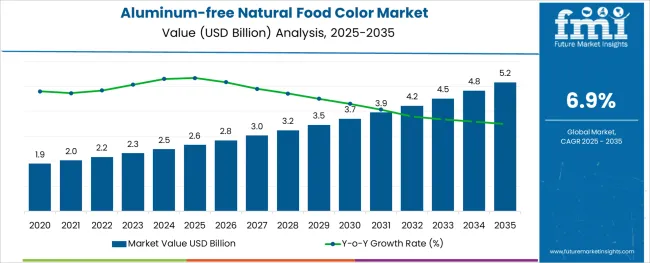
The aluminum-free natural food color market is progressing steadily as food and beverage manufacturers shift toward clean label ingredients that meet consumer expectations for natural and safe products. Rising health awareness and changing food safety standards have encouraged the replacement of synthetic and metal-based colorants with plant-derived alternatives. Innovations in natural extraction processes and stabilization technologies have enhanced the color vibrancy and shelf life of natural food colors, making them suitable for a wider range of applications.
In addition, global food brands have expanded their product portfolios to feature naturally colored variants, driven by consumer demand for transparency in product formulations. Regulatory guidelines restricting the use of synthetic additives have further supported this market transition.
Moving forward, the market is likely to expand with the development of heat-stable and pH-resistant natural colorants. Growth within the market is expected to be driven by Beta Carotene in the type segment and Beverages as the key end-use application.
The market is segmented by Type and End-use Application and region. By Type, the market is divided into Beta Carotene, Astaxanthin, Annatto, Curcumin, Spirulina, and Carmine. In terms of End-use Application, the market is classified into Beverages, Processed/Frozen Food Products, Dairy Products, Bakery and Confectionary Products, and Others. Regionally, the market is classified into North America, Latin America, Western Europe, Eastern Europe, Balkan & Baltic Countries, Russia & Belarus, Central Asia, East Asia, South Asia & Pacific, and the Middle East & Africa.
The market is segmented by Type and End-use Application and region. By Type, the market is divided into Beta Carotene, Astaxanthin, Annatto, Curcumin, Spirulina, and Carmine. In terms of End-use Application, the market is classified into Beverages, Processed/Frozen Food Products, Dairy Products, Bakery and Confectionary Products, and Others. Regionally, the market is classified into North America, Latin America, Western Europe, Eastern Europe, Balkan & Baltic Countries, Russia & Belarus, Central Asia, East Asia, South Asia & Pacific, and the Middle East & Africa.
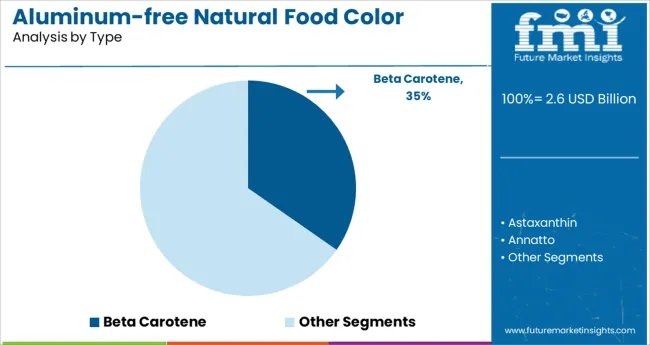
The Beta Carotene segment is expected to hold 34.7% of the aluminum-free natural food color market revenue in 2025, maintaining its leadership within the type category. The demand for beta carotene has been driven by its vibrant orange to yellow hues which are widely used in food and beverage formulations. Its dual role as a colorant and a pro-vitamin source has further increased its appeal among health-conscious consumers.
Food manufacturers have preferred beta carotene due to its plant-based origin and broad compatibility with different food matrices. Moreover, its improved stability in various processing conditions has supported its use in shelf-stable products.
As consumer preference continues to shift toward natural and functional ingredients, the Beta Carotene segment is projected to sustain its strong market presence.
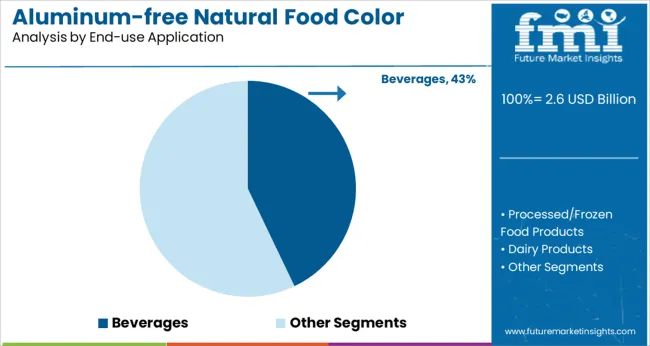
The Beverages segment is projected to account for 42.9% of the aluminum-free natural food color market revenue in 2025, making it the leading end-use application. This segment has benefited from increasing demand for naturally colored drinks in categories such as fruit juices, functional beverages, and flavored waters. Beverage manufacturers have adopted aluminum-free natural colors to align with clean label trends and meet regulatory standards for additive-free formulations.
The wide consumption base and product diversity within the beverage industry have further contributed to consistent colorant demand. Additionally, innovations in color stabilization have improved the compatibility of natural food colors with various beverage formulations including acidic and transparent liquids.
As brands continue to expand their naturally formulated drink portfolios, the Beverages segment is expected to remain a major driver of market growth.
The market size of aluminum-free natural food colors is projected to show impressive growth during the forecast period. The growth is primarily attributed to the fact that there is a constant rise in consumer preference for consuming clean-labeled products.
Rising concerns over health hazards associated with the intake of synthetic food colors are amplifying the demand for aluminum-free natural food colors in many parts of the world.
Aluminum is identified as a neurotoxin that can affect over 200 biological functions of the body. Prolonged accumulation in the human system over periods of time can have adverse consequences, potentially causing neurodegenerative diseases like dementia, Alzheimer’s disease, Parkinson’s, and amyotrophic lateral sclerosis (ALS).
Aluminum competes with other minerals for absorption into the bloodstream, significantly deterring calcium absorption in bones, and impacting skeletal mineralization. Accumulation of aluminum can develop autism and slow down growth in kids.
Growing awareness about the adverse impact of aluminum on human health is fueling the food and beverage industry to seek alternatives to food coloring containing aluminum.
A recent survey of Germany, conducted by the Federal Institute of Risk Assessment has revealed that half of the German populace avoids the use of aluminum-based products. This factor is estimated to play a vital driver in the aluminum-free natural food color market growth.
Mindful choices are gaining traction with a burgeoning demand for naturally sourced ingredients for food products, associating natural with healthy is driving manufacturers to adopt aluminum-free natural food colors for their products.
However, natural food colors have a very less shelf life and inefficient functionality. In addition, coloring can fade easily and undergo a change in properties when subjected to different pH levels and light.
The overall cost of production of natural food colors is higher than that of synthetic counterparts. The requirement for the vast amount of raw materials in fruits, plants, and other natural sources for the production of aluminum-free natural food colors is non-sustainable and expensive.
These factors are restraining the widespread adoption of aluminum-free natural food colors and are continuing to pose a daunting challenge in the aluminum-free natural food color market.
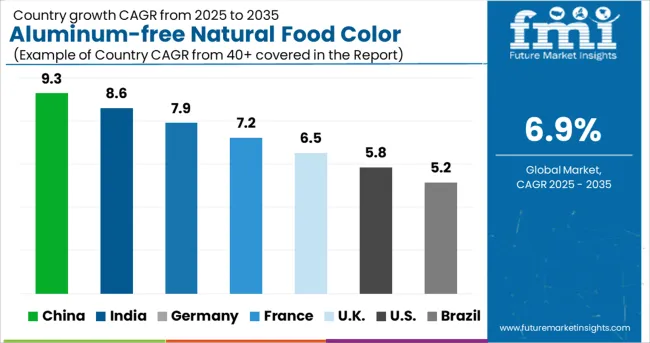
At present, the North American and European regions are anticipated to hold the major shares in the global market of aluminum-free natural food color market. There are stringent regulations across many countries in these regions regarding the usage of aluminum-free natural food colors.
However, on the other hand, the Asia-Pacific region is projected to show lucrative growth opportunities for the market players. The demand for aluminum-free natural food colors is increasing due to increased purchasing power coupled with the growing consumer preference for natural ingredients.
The rising consumption of organic food products has necessitated a shift towards natural and healthier alternatives. The demand for aluminum-free natural food colors is bolstering across these regions and playing a significant role in shaping the aluminum-free natural food colors market growth during the forecast period.
Some of the notable developments in the aluminum-free natural food color market are
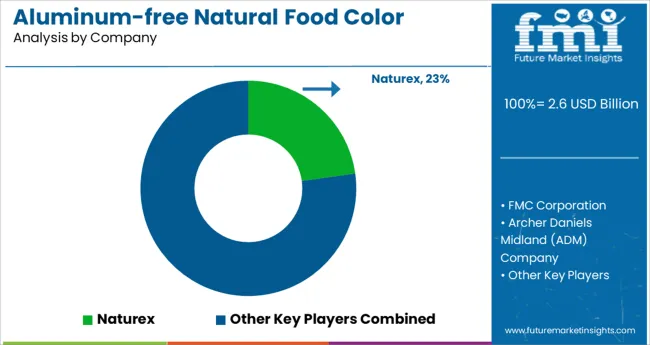
Some of the notable players in the Aluminum-free natural food color market are ADM, NATUREX, Hansen A/S, Döhler GmbH, McCormick & Company, Inc., Kalsec Inc., ROHA Dyechem Pvt. Ltd., San-Ei GEN FFI Inc., DDW The Color House, Diana Food S.A.S., GNT Group B.V., Synthite Industries Ltd.
| Report Attribute | Details |
|---|---|
| Growth Rate | CAGR of 6.88% from 2025 to 2035 |
| Base Year for Estimation | 2024 |
| Historical Data | 2020 to 2024 |
| Forecast Period | 2025 to 2035 |
| Quantitative Units | Revenue in million and CAGR from 2025 to 2035 |
| Report Coverage | Revenue Forecast, Volume Forecast, Company Ranking, Competitive Landscape, Growth Factors, Trends, and Pricing Analysis |
| Segments Covered | Type, Source, Form, Application, Region |
| Regions Covered | North America; Latin America; Europe; East Asia; South Asia; Oceania; Middle East and Africa |
| Key Countries Profiled | USA, Canada, Brazil, Argentina, Germany, United Kingdom, France, Spain, Italy, Nordics, BENELUX, Australia & New Zealand, China, India, ASIAN, GCC Countries, South Africa |
| Key Companies Profiled | ADM; NATUREX; Hansen A/S; Döhler GmbH; McCormick & Company, Inc.; Kalsec Inc.; ROHA Dyechem Pvt. Ltd.; San-Ei GEN FFI Inc; DDW The Color House; Diana Food S.A.S.; GNT Group B.V.; Synthite Industries Ltd. |
| Customization | Available Upon Request |
The global aluminum-free natural food color market is estimated to be valued at USD 2.6 billion in 2025.
It is projected to reach USD 5.2 billion by 2035.
The market is expected to grow at a 6.9% CAGR between 2025 and 2035.
The key product types are beta carotene, astaxanthin, annatto, curcumin, spirulina and carmine.
beverages segment is expected to dominate with a 42.9% industry share in 2025.






Full Research Suite comprises of:
Market outlook & trends analysis
Interviews & case studies
Strategic recommendations
Vendor profiles & capabilities analysis
5-year forecasts
8 regions and 60+ country-level data splits
Market segment data splits
12 months of continuous data updates
DELIVERED AS:
PDF EXCEL ONLINE
Aluminum-Free Food Pouch Market Size and Share Forecast Outlook 2025 to 2035
Natural Antioxidant Market Size and Share Forecast Outlook 2025 to 2035
Natural Disaster Detection IoT Market Forecast Outlook 2025 to 2035
Natural Polymer Market Size and Share Forecast Outlook 2025 to 2035
Natural Gas Analyzers Market Size and Share Forecast Outlook 2025 to 2035
Natural Mineral Oil Coolant Market Size and Share Forecast Outlook 2025 to 2035
Natural Synthetic Cytokinin (Anti-zeatin Riboside) Market Size and Share Forecast Outlook 2025 to 2035
Natural Silicone Alternative Market Analysis - Size and Share Forecast Outlook 2025 to 2035
Natural Skincare Preservatives Market Analysis - Size and Share Forecast Outlook 2025 to 2035
Natural Surfactant Market Size and Share Forecast Outlook 2025 to 2035
Natural Bitterness Blockers Market Analysis - Size And Share Forecast Outlook 2025 To 2035
Natural Refrigerants Market Size and Share Forecast Outlook 2025 to 2035
Natural Ferulic Acid Market Size and Share Forecast Outlook 2025 to 2035
Natural Vitamin E Product Market Size and Share Forecast Outlook 2025 to 2035
Natural Oil Polyols NOP Market Size and Share Forecast Outlook 2025 to 2035
Natural Rubber Market Size and Share Forecast Outlook 2025 to 2035
Natural Language Processing in Finance Market Size and Share Forecast Outlook 2025 to 2035
Naturally Derived Fatty Alcohol Market Size and Share Forecast Outlook 2025 to 2035
Natural Fiber Composites Market Size and Share Forecast Outlook 2025 to 2035
Naturally Derived Sweeteners Market Size and Share Forecast Outlook 2025 to 2035

Thank you!
You will receive an email from our Business Development Manager. Please be sure to check your SPAM/JUNK folder too.
Chat With
MaRIA